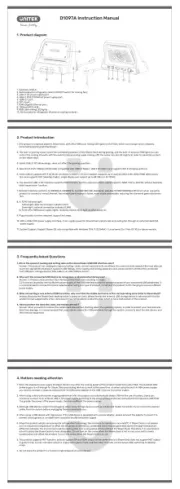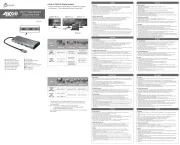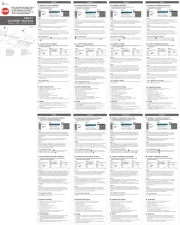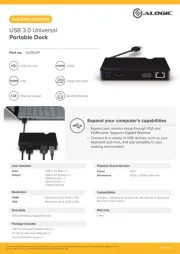Vimar 14585 Handleiding
Vimar
Cradle/docking station
14585
Bekijk gratis de handleiding van Vimar 14585 (6 pagina’s), behorend tot de categorie Cradle/docking station. Deze gids werd als nuttig beoordeeld door 31 mensen en kreeg gemiddeld 4.6 sterren uit 16 reviews. Heb je een vraag over Vimar 14585 of wil je andere gebruikers van dit product iets vragen? Stel een vraag
Pagina 1/6

Viale Vicenza, 14 - 36063 Marostica VI - Italy
Tel. +39 0424 488 600 - Fax (Italia) +39 0424 488 188
Fax (Export) +39 0424 488 709
www.vimar.com
49400362C0 01 1412
VIMAR - Marostica - Italy
ITALIANO
Docking station per dispositivi iPod e iPhone , fornita con alimentatore ® ®
- 2 moduli. (L’articolo è composto da 2 apparecchi di 2 moduli ciascuno,
installabili anche separatamente).
La docking station è un dispositivo trasmettitore che permette di connettere sorgenti audio
quali iPod (o altri lettori mp3, lettori CD, ecc.) al sistema di diffusione sonora. E’ ®/iPhone®
costituita da un apparecchio ad incasso dotato di docking station per l’alloggiamento di iPod®/
iPhone® e da una secondo apparecchio, sempre con meccanica 2 moduli da incasso, che
fornisce l’alimentazione (5 V 1A) dedicata alla carica della batteria. Il dispositivo, oltre all’invio
del segnale audio ai dispositivi ricevitori, permette anche il controllo remoto dell’iPod®/iPhone®
(funzioni di play/pause, skip+/- traccia, navigazione del database, impostazioni proprietà di
riproduzione), mediante l’invio di opportuni comandi sul bus. È inoltre presente un ingresso jack
da 3,5 mm ausiliario per il collegamento di sorgenti sonore diverse dai prodotti Apple (lettori
mp3, lettori CD, ecc.) che siano dotate di uscita stereo e controllabili esclusivamente attraverso
la propria interfaccia di comando.
CARATTERISTICHE.
Docking station.
• Tensione nominale di alimentazione: BUS 29 V
• Consumo: 35 mA
• Morsetti:
1) 2 per il bus diffusione sonora
2) 2 per un’uscita bus By-me dove collegare fino a 3 dispositivi By-me
3) 2 per collegamento caricabatteria 5 V 1 A.
• Connettore 30 poli per dispositivi Apple iPod®/iPhone®.
• Ingresso jack 3.5 mm ausiliario per lettori mp3 (autoesclusione audio iPod®/iPhone® quando
è inserito il jack).
• Disaccoppiamento galvanico degli ingressi audio rispetto al bus By-me.
• Possibilità di regolazione manuale della sensibilità dell’ingresso audio.
• Temperatura di funzionamento: 0 ÷ +45 °C (per interno)
• Installazione: a incasso o a parete (con scatola da parete 09975…)
• Pulsante di configurazione e regolazione manuale della sensibilità dell’ingresso audio.
• Led di configurazione, regolazione manuale della sensibilità dell’ingresso audio e indicazione
dello stato di funzionamento ON/OFF
• Ponticelli per inserire la terminazione di linea audio
Caricabatteria.
• Tensione nominale di alimentazione: 100-230V~ 50/60Hz
• Uscita: 5 V 1 A (max)
• Morsetti:
1) 2 per ingresso tensione di rete
2) 2 per l’uscita carica batteria dispositivi iPod connessi alla docking station®/iPhone®
N.B. Il collegamento tra la docking station e il caricabatteria deve essere il più corto possibile.
CONFIGURAZIONE.
PER LE OPERAZIONI DI CONFIGURAZIONE SI VEDA IL MANUALE ISTRUZIONI
DEL SISTEMA By-me.
• Blocchi funzionali: 1
• Selezione del blocco funzionale (configurazione): durante la creazione dei gruppi,
premere il pulsante di configurazione e attendere l’accensione del led.
A led acceso, la centrale configura il blocco funzionale; al termine dell’operazione il led
si spegne.
Impostazioni configurabili direttamente dal dispositivo
La regolazione manuale della sensibilità degli ingressi audio sul dispositivo viene effettuata
come segue:
- Attivare il dispositivo (led di stato acceso) accendendo una zona d’ascolto.
- Premere e mantenere premuto il pulsante di configurazione per aumentare la sensibilità.
Il led lampeggia velocemente; quando si raggiunge il valore massimo o si rilascia il pulsante, il
led ritorna al suo stato di funzionamento normale.
- Premere e mantenere premuto il pulsante di configurazione per diminuire la sensibilità.
Il led lampeggia lentamente; quando si raggiunge il valore minimo o si rilascia il pulsante, il led
ritorna al suo stato di funzionamento normale.
- Ogni volta che si preme il pulsante di configurazione si inverte il verso di regolazione
della sensibilità.
L’intera scala di regolazione può essere percorsa dal valore minimo a quello massimo o vice-
versa in circa 60 sec.
Come nel funzionamento normale, anche nel corso della regolazione il lampeggio ad alta
frequenza del led indica che l’intensità dell’audio in ingresso si sta avvicinando alla soglia mas-
sima. La regolazione ottimale è raggiunta quando il led lampeggia spesso ad alta frequenza: il
led acceso fisso infatti indica un segnale d’ingresso troppo basso mentre il led costantemente
in lampeggio ad alta frequenza indica un segnale d’ingresso troppo alto.
IMPORTANTE: Se dal morsetto del bus audio non è presente un’ulteriore diramazione
per il collegamento di altri dispositivi audio (cioè se il dispositivo è il primo o l’ultimo di
un ramo audio), vanno chiusi i ponticelli vicini al morsetto stesso (COLLEGAMENTI - fig.
3); diversamente vanno lasciati aperti. Ogni estremità del bus diffusione sonora deve
sempre essere terminata.
CONFORMITÀ NORMATIVA.
Per Docking station:
Direttiva EMC.
Norme EN 50428, EN 55022, EN 55024.
Per Caricabatteria:
Direttiva BT.
Direttiva EMC.
Norme EN 62684, EN 60950, EN 301 489-34.
iPhone, iPod, iPod classic, iPod nano, iPod shuffle e iPod touch sono marchi registrati di Apple Inc
negli Stati
Uniti e/o in altri paesi.
ENGLISH
Docking station for iPod® and iPhone devices, supplied with power supply - 2 ®
modules (the article is composed of 2 appliances of 2 modules each).
The docking station is a transmitter device which is used to connect audio sources such as
iPod /iPhone® ® (or other mp3 players, CD players, etc.) to the speaker system.
It comprises a flush mounted device fitted with a docking station to house the iPod®/iPhone®
and a second device, again with 2 flush mounted modules which supplies power (5 V 1A) and
a dedicated battery charger.The device not only sends an audio signal to the receiver devices,
but also remotely controls the iPod / iPhone (play/stop, skip+/- track, database navigation, ® ®
reproduction property settings), by sending the appropriate commands to the bus.
It also has a 3.5 mm auxiliary jack input to connect audio sources other than Apple products
(mp3 players, CD players, etc.) fitted with a stereo output and which are controlled only from their
own control interface.
CHARACTERISTICS.
Docking station.
• Rated supply voltage BUS 29 V.
• Consumption 35 mA.
• Terminals:
1) 2 for the speaker system bus.
2) 2 for a bus By-me output for connecting up to 3 By-me devices.
3) 2 for connecting the 5 V 1 A battery charger.
• 30-pin connector for Apple iPod®/iPhone® devices.
• 3.5 mm auxiliary jack input for mp3 players (iPod®/iPhone® audio automatically excluded
when the jack is in).
• Galvanic decoupling of the audio inputs in relation to the By-me bus.
• Possibility to manually adjust the audio input sensitivity.
• Operating temperature 0 - +45 °C (for indoor use).
• Installation: flush or surface mounting (with surface mounting box 09975…).
• Configuration button and possibility to manually adjust the audio input sensitivity.
• Configuration LED, manual audio input sensitivity adjustment and ON/OFF status indicator.
• Jumper to insert the audio line termination.
Battery charger.
• Rated supply voltage 100-230V~ 50/60Hz.
• Output 5 V 1 A (max).
• Terminals:
1) 2 for voltage input.
2) 2 for battery charger output for iPod®/iPhone® devices connected to the docking station.
NB: The connection between the docking station and the battery charger must always
be as short as possible.
CONFIGURATION.
FOR CONFIGURATION OPERATIONS, SEE THE By-me SYSTEM
INSTRUCTIONS.
• Functional blocks: 1
• To select the functional block (configuration): during group creation, press the configu-
ration button and wait for the LED to light up.
With the LED on, the control unit will configure the functional block; at the end of this
operation the LED will go out.
Settings which can be configured directly from the device
To manually adjust the sensitivity of the audio inputs on the device, proceed as follows:
- Activate the device (status LED on) by switching on a listening zone.
- Press and hold the configuration push-button to increase the sensitivity.
The LED blinks rapidly; when the maximum value is reached or the push-button is released, the
LED returns to its normal operating status.
- Press and hold the configuration push-button to decrease the sensitivity.
The LED blinks slowly; when the minimum value is reached or the push-button is released, the
LED returns to its normal operating status.
- Whenever the configuration push-button is pressed, the sensitivity adjustment is inverted.
It is possible to run through the whole sensitivity adjustment scale, from the minimum to the
maximum value and vice versa in approximately 60 sec.
Just as in normal operation, during adjustment the high-frequency blinking of the LED indicates
that the input audio intensity is approaching the maximum threshold.
The optimal setting is reached when the LED often blinks at high frequency: the LED on steady
Eikon
20585
Arké
19585
Plana
14585

Viale Vicenza, 14 - 36063 Marostica VI - Italy
Tel. +39 0424 488 600 - Fax (Italia) +39 0424 488 188
Fax (Export) +39 0424 488 709
www.vimar.com
indicates too low an input signal while the LED constantly blinking at high frequency indicates
too high an input signal.
IMPORTANT: If there is no additional branch from the audio bus terminal to connect other
audio devices (if the device is the first or last of an audio branch), the bridges near the
terminal (CONNECTIONS - fig. 3) must be closed; otherwise they must be left open. Each
end of the speaker system bus must always be terminated.
CONFORMITY.
For Docking station:
EMC
directive
.
Standards
EN 50428, EN 55022, EN 55024.
For Battery charger:
BT
directive
.
EMC
directive
.
Standards
EN 62684, EN 60950, EN 301 489-34.
iPhone, iPod, iPod classic, iPod nano, iPod shuffle, and iPod touch are trademarks of Apple Inc., registered
in the U.S. and other countries.
FRANÇAIS
Station d’accueil pour dispositifs iPod et iPhone, livrée avec alimentateur -
2 modules. (L’article se compose de 2 appareils de 2 modules chacun, qui
peuvent être installés séparément)
La station d’accueil est un transmetteur qui permet de connecter des sources audio type iPod/
iPhone (et autres lecteurs MP3, lecteurs CD, etc) au système de diffusion sonore.
Il se compose d’un appareil encastrable avec Station d’accueil pour loger les iPod/iPhone
et d’un second appareil, toujours avec 2 modules encastrables qui alimente (5 V 1A).
Le dispositif assure l’envoi du signal audio aux récepteurs et la commande à distance de l’iPod/
iPhone (fonctions play/stop, skip+/- piste, navigation dans la base de données, paramétrage
des fonctions de reproduction), en envoyant les commandes appropriées sur le bus.
Il possède également une entrée jack auxiliaire de 3,5 mm pour le raccordement des sources
sonores autres que les produits Apple (lecteurs MP3, lecteurs CD, etc) équipées de sorties
stereo et ne pouvant être pilotées que par leur interface de commande.
CARACTÉRISTIQUES.
Station d’accueil.
• Tension nominale d’alimentation: BUS 29 V
• Consommation: 35 mA
• Bornes:
1) 2 pour le bus de diffusion sonore
2) 2 pour une sortie bus By-me permettant de connecter 3 dispositifs By-me
3) 2 pour raccord du chargeur de batterie 5 V 1 A.
• Connecteur 30 pôles pour dispositifs Apple iPod/iPhone.
• Entrée jack 3,5 mm auxiliaire pour lecteurs MP3 (auto-exclusion de l’audio iPod/iPhone
quand le jack est branché.
• Découplage galvanique des entrées audio et du bus By-me.
• Réglage manuel de la sensibilité de l’entrée audio.
• Température de fonctionnement 0 ÷ + 45 °C (intérieur)
• Installation encastrée ou murale (avec boîtier mural 09975).
• Bouton de configuration et réglage manuel de la sensibilité de l’entrée audio.
• Led de configuration et réglage manuel de la sensibilité de l’entrée audio ; témoin d’état de
fonctionnement ON/OFF.
• Cavalieres permettant de brancher la terminaison de la ligne audio.
Chargeur de batterie.
• Tension nominale d’alimentation: 100-230V~ 50/60Hz
• Sortie 5 V 1 A (max)
• Bornes:
1) 2 pour entrée tension du réseau
2) 2 pour sortie chargeur de batterie des dispositifs iPod/iPhone connectés à la Station
d’accueil.
N.B. Le raccordement entre la docking station et le chargeur de batterie doit être le plus
court possible.
CONFIGURATION.
POUR LES OPÉRATIONS DE CONFIGURATION, VOIR LE MANUEL
D’INSTRUCTIONS DU SYSTÈME By-me JOINT À LA CENTRALE DE
COMMANDE.
• Blocs fonctionnels : 1
• Sélection du bloc fonctionnel (configuration): pendant la création des groupes,
appuyer sur le bouton de configuration et attendre que la led s’allume.
Lorsque la led est allumée, la centrale configure le bloc fonctionnel ; à la fin de l’opéra-
tion, la led s’éteint.
Paramètres devant être configurés directement à partir du dispositif.
Régler à la main la sensibilité des entrées audio sur le dispositif dans l’ordre suivant:
- allumer le dispositif (led allumée)
- appuyer sur la touche de configuration jusqu’à entrer dans la fonction de réglage (clignote-
ment rapide de la led)
- maintenir à nouveau la pression sur la touche de configuration pour augmenter la sensibilité
(clignotement lent de la led; la led s’éteint à la valeur maximale)
- maintenir à nouveau la pression sur la touche de configuration pour diminuer la sensibilité
(clignotement lent de la led; la led s’éteint à la valeur minimale)
- chaque pression sur la touche de configuration inverse le sens du réglage de la sensibilité
La plage de réglage peut être parcourue entièrement en 60 s environ.
En fonctionnement normal et pendant le réglage, le clignotement de la led à haute fréquence
indique que l’intensité du son en entrée est proche du maximum. Le réglage optimal est atteint
quand la led clignote souvent à haute fréquence. La led allumée fixe indique un signal d’entrée
trop bas, la led qui clignote constamment à haute fréquence indique un signal d’entrée trop
haut.
IMPORTANT: Si aucune autre dérivation ne part de la borne du bus audio pour connecter
d’autres dispositifs audio supplémentaires (le dispositif est le premier et le dernier d’une
branche audio), fermer le cavalier près de la borne (CONNEXIONS
- fig. 3) ; sinon le
laisser ouvert. Chaque extrémité du bus de diffusion sonore doit être terminée.
CONFORMITÉ AUX NORMES.
Pour Station d’accueil:
Directive CEM.
Normes EN 50428, EN 55002, EN 55024.
For Chargeur de batterie.
D
irective BT
.
Directive CEM.
Normes
EN 62684, EN 60950, EN 301 489-34.
iPhone, iPod, iPod classic, iPod nano, iPod shuffle et Pod touch sont des marques enregistrées par
Apple Inc aux États-Unis et/ou dans d’autres pays.
DEUTSCH
Dockingstation für iPod und iPhone, mit Netzteil - 2 Module. (Der Artikel
beinhaltet 2 Geräte mit jeweils 2 auch separat installierbaren Modulen)
Die Dockingstation ist ein Gerät für die Verbindung von Audioquellen wie iPod/iPhone (oder
andere MP3-Player, CD-Player usw.) an das Beschallungssystem.
Sie besteht aus einem Unterputzgerät mit Dockingstation für die Aufnahme von iPod/iPhone
sowie aus einem zweiten 2-Modul-Unterputzgerät für die Versorgung (5 V 1 A).
Das Gerät sendet nicht nur das Audiosignal an die Empfangsgeräte, es ermöglicht ebenfalls
die Fernbedienung des iPod/ iPhone (Funktionen Wiedergabe/Stopp, Vor-/Zurückspringen,
Datenbank-Navigation, Einstellung der Wiedergabeeigenschaften) durch entsprechende
Befehle an den Bus.
Darüber hinaus ist ein zusätzlicher 3,5mm Jack-Eingang vorhanden für den Anschluss ande-
rer Audioquellen als Apple-Produkte (MP3-Player, CD-Player usw.) mit Stereo-Ausgang und
Bedienung ausschließlich über die eigene Steuerschnittstelle.
TECHNISCHE MERKMALE.
Dockingstation.
• Nennversorgungsspannung: BUS 29 V
• Stromverbrauch: 35 mA
• Klemmen:
1) 2 für den Beschallungsbus
2) 2 für einen By-me-Bus-Ausgang zum Anschluss von bis zu 3 By-me-Geräten
3) 2 für den Anschluss Batterieladegerät 5 V 1 A.
• 30-poliger Stecker für Apple-Geräte iPod/iPhone.
• 3,5 mm für MP3-Player (automatische iPod/iPhone-Audioabschaltung bei Jack-Eingang
eingestecktem Jack).
• Galvanische Entkopplung der Audioeingänge vom By-me-Bus.
• Manuelle Empfindlichkeitsregelung des Audioeingangs.
• Betriebstemperatur 0 ÷ +45 °C (für innen)
• Installation: Unterputz oder Wand (mit Wanddose 09975…)
• Konfigurationstaste und manuelle Empfindlichkeitsregelung des Audioeingangs.
• LED für Konfiguration, manuelle Empfindlichkeitsregelung des Audioeingangs und Anzeige
des ON/OFF Betriebszustands
• Schaltbrücke für Audioleitungsabschluss
Batterieladegerät.
• Tensione nominale di alimentazione: 100-230V~ 50/60Hz
• Uscita: 5 V 1 A (max)
• Klemmen:
1) 2 für Netzspannungseingang.
2) 2 für Ausgang Batterieladegerät iPod/iPhone auf der Dockingstation.
Eikon
20585
Arké
19585
Plana
14585

Viale Vicenza, 14 - 36063 Marostica VI - Italy
Tel. +39 0424 488 600 - Fax (Italia) +39 0424 488 188
Fax (Export) +39 0424 488 709
www.vimar.com
Hinweis Die Verbindung zwischen Dockingstation und Akku-Ladegerät muss so kurz
wie möglich sein.
KONFIGURATION.
HINSICHTLICH DER KONFIGURATIONSVORGÄNGE WIRD AUF DIE DEM
STEUERGERÄT BEILIEGENDE BETRIEBSANLEITUNG DES SYSTEMS By-me
VERWIESEN .
• Funktionsblöcke: 1
• Wahl des Funktionsblocks (Konfiguration): beim Erstellen der Gruppen die
Konfigurationstaste drücken und auf das Aufleuchten der LED warten.
Nach Aufleuchten der LED konfiguriert die Steuereinheit den Funktionsblock;
anschließend erlischt die LED.
Direkt vom Gerät aus konfigurierbare Einstellungen.
Die Empfindlichkeit der Audio-Eingänge am Gerät wird wie folgt von Hand eingestellt:
- Gerät aktivieren (Status-LED ein) und eine Audiozone einschalten.
- Die Konfigurationstaste drücken und gedrückt halten, um die Empfindlichkeit zu erhöhen.
Die LED blinkt schnell; wenn der Höchstwert erreicht oder die Taste losgelassen wird, kehrt
die LED zu ihrem normalen Betriebszustand zurück.
- Die Konfigurationstaste drücken und gedrückt halten, um die Empfindlichkeit zu verringern.
Die LED blinkt langsam; wenn der Mindestwert erreicht oder die Taste losgelassen wird, kehrt
die LED zu ihrem normalen Betriebszustand zurück.
- Mit jedem Druck der Konfigurationstaste wird die Einstellrichtung der Empfindlichkeit geändert.
Der gesamte Einstellungsbereich vom Mindest- bis zum Höchstwert, oder umgekehrt, kann in
ca. 60 Sekunden durchlaufen werden.
Wie schon im Normalbetrieb weist das Blinken mit hoher Frequenz der Led auch während
der Regelung darauf hin, dass sich die Stärke des eingehenden Audiosignals dem maximalen
Schwellenwert nähert. Die optimale Regelung ist gegeben, wenn die Led häufig mit hoher
Frequenz blinkt; eine permanent leuchtende Led zeigt ein zu schwaches Eingangssignal an,
während eine konstant mit hoher Frequenz blinkende Led ein zu starkes Eingangssignal meldet.
WICHTIG: Liegt an der Audiobusklemme keine Abzweigung für den Anschluss weiterer
Audiogeräte vor (also wenn es sich um das erste oder letzte Gerät in einem Audiozweig
handelt), sind die Steckbrücken neben der Klemme zu schließen (ANSCHLÜSSE
- Abb.
3); andernfalls muss sie geöffnet bleiben. Der Beschallungsbus muss an jedem Ende
einen Abschluss aufweisen.
NORMKONFORMITÄT.
Dockingstation.
EMV-Richtlinie
Normen EN 50428, EN 55002, EN 55024.
Batterieladegerät.
BT-Richtlinie. EMV-Richtlinie
Normes
EN 62684, EN 60950, EN 301 489-34.
iPhone, iPod, iPod classic, iPod nano, iPod shuffle und iPod touch sind eingetragene Warenzeichen
von Apple Inc in den Vereinigten Staaten und in anderen Ländern.
ESPAÑOL
Estación de acoplamiento para dispositivos iPod e iPhone, con alimentador
- 2 módulos (artículo formado por 2 aparatos de 2 módulos cada uno, que
se pueden instalar por separado).
La estación de acoplamiento es un dispositivo transmisor que permite conectar fuentes de
audio como iPod/iPhone (u otros lectores mp3, lectores CD, etc.) al sistema de difusión sonora.
Está formado por un aparato de empotrar dotado con estación de acoplamiento para alojar
iPod/iPhone y por otro aparato, siempre con mecánica de 2 módulos de empotrar, que sumi-
nistra la alimentación (5 V 1 A) y el cargador de batería.
El dispositivo, además de enviar la señal de audio a los dispositivos receptores, también permite
el control a distancia del iPod/ iPhone (funciones play/stop, skip+/- pista, navegación en la base
de datos, configurar las propiedades de reproducción) mediante el envío de mandos al bus.
También cuenta con una entrada jack de 3,5mm auxiliar para conectar fuentes sonoras dife-
rentes de los productos Apple (lectores mp3, lectores CD, etc.) que posean una salida stereo
y que sólo se pueden controlar mediante su interfaz de mando.
CARACTERÍSTICAS.
Estación de acoplamiento.
• Tensión nominal de alimentación: BUS 29 V
• Consumo: 35 mA
• Bornes:
1) Dos para el bus de difusión sonora
2) Dos para la salida bus By-me a la cual se pueden conectar hasta tres dispositivos By-me
3) Dos para conectar un cargador de batería 5 V 1 A (max).
• Conector de 30 polos para dispositivos Apple iPod/iPhone.
• Entrada jack de 3,5 mm auxiliar para lectores mp3 (se inhabilita el audio de los dispositivos iPod/
iPhone cuando se p3-ha enchufado el conector).
• Desacoplamiento galvánico de las entradas de audio con respeto al bus By-me.
• Posibilidad de regular manualmente la sensibilidad de la entrada de audio.
• Temperatura de funcionamiento: 0 ÷ +45 °C (para interiores)
• Instalación: de empotrar o de superficie (con caja de superficie 09975…)
• Pulsador de configuración y regulación manual de la sensibilidad de la entrada de audio.
• Led de configuración, regulación manual de la sensibilidad de la entrada de audio e indica-
ción del estado de funcionamiento ON/OFF
• Puente para insertar la terminación de la línea de audio
Cargador de batería.
• Tensión nominal de alimentación: 110V/230V~ y 50/60Hz
• Salida: 5 V 1 A (máx)
• Bornes:
1) Dos para entrada de tensión de red.
2) Dos para la salida del cargador de batería de los dispositivos iPod/iPhone conectados
a la estación.
N.B.: la conexión entre la estación de acoplamiento y el cargador de batería tiene que
ser lo más corta posible.
CONFIGURACIÓN.
PARA LAS OPERACIONES DE CONFIGURACIÓN, VÉASE EL MANUAL DE
INSTRUCCIONES DEL SISTEMA By-me.
• Bloques funcionales: 1
• Selección del bloque funcional (configuración): durante la creación de los grupos,
presionar el pulsador de configuración y esperar a que se encienda el led.
Con el led encendido, la centralita configura el bloque funcional; al término de la ope-
ración, el led se apaga.
Configuraciones que se pueden realizar directamente desde el dispositivo.
La sensibilidad de las entradas de audio en el dispositivo se regula manualmente de la siguiente manera:
- Activar el dispositivo (led de estado encendido) encendiendo una zona de escucha.
- Mantener presionado el pulsador de configuración para aumentar la sensibilidad.
El led parpadea velozmente. Cuando se alcanza el valor máximo o se suelta el pulsador, el
led vuelve a funcionar normalmente.
- Mantener presionado el pulsador de configuración para disminuir la sensibilidad.
El led parpadea lentamente. Cuando se alcanza el valor mínimo o se suelta el pulsador, el led
vuelve a funcionar normalmente.
- Cada vez que se presiona el pulsador de configuración, se invierte el sentido de regulación
de la sensibilidad.
Toda la escala de regulación, desde el valor mínimo hasta el máximo o viceversa, se puede
recorrer en unos 60 segundos.
Al igual que en el funcionamiento normal, durante la regulación el parpadeo rápido del led indi-
ca que la intensidad del audio de entrada se está acercando al umbral máximo. La regulación
óptima se obtiene cuando el led parpadea a menudo rápidamente; en efecto, el led encendido
fijo indica que la señal de entrada es demasiado baja y el parpadeo rápido y constante del led
indica una señal de entrada demasiado alta.
IMPORTANTE: si desde el borne del bus audio no existe ninguna derivación para conec-
tar otros dispositivos de audio (es decir, si el dispositivo es el primero o el último de un
ramal de audio), hay que cerrar los puentes al lado del borne (CONEXIONES -
fig. 3);
en caso contrario, siempre se tienen que dejar abiertos. Los dos extremos del bus de
difusión sonora han de estar terminados.
CONFORMIDAD NORMATIVA.
Estación de acoplamiento:
Directiva EMC.
Normas EN 50428, EN 55002 y EN 55024.
Cargador de batería:
Directiva BT. Directiva EMC.
Normas EN 62684, EN 60950 y EN 301 489-34.
iPhone, iPod, iPod classic, iPod nano, iPod shuffle e iPod touch son marcas registradas de Apple
Inc en los Estados Unidos y en otros países.
ΕΛΛΗΝΙΚΑ
Βάση σύνδεσης για συσκευές iPod και iPhone, με τροφοδοτικό - 2 μονάδες.
(Το προϊόν αποτελείται από 2 συσκευές 2 μονάδων η καθεμία που μπορούν
να εγκατασταθούν ακόμη και ξεχωριστά).
Η βάση σύνδεσης είναι μια συσκευή πομπού που παρέχει τη δυνατότητα σύνδεσης
πηγών ήχου, όπως iPod/iPhone (ή άλλων συσκευών αναπαραγωγής mp3, συσκευών
αναπαραγωγής CD, κλπ.) στο σύστημα ηχητικής εγκατάστασης. Αποτελείται από μια
συσκευή χωνευτής εγκατάστασης που διαθέτει βάση σύνδεσης για την τοποθέτηση του iPod/
iPhone, μια δεύτερη συσκευή, πάντα με μηχανισμό χωνευτής εγκατάστασης 2 μονάδων για
την παροχή τροφοδοσίας (5 V 1 A). Η συσκευή, εκτός από την αποστολή του σήματος
ήχου στις συσκευές δέκτη, παρέχει επίσης τη δυνατότητα απομακρυσμένου ελέγχου του
iPod/ iPhone (λειτουργίες αναπαραγωγής/διακοπής, παράλειψη κομματιού +/- πλοήγηση
στη βάση δεδομένων, +/-, πλοήγηση στη βάση δεδομένων, ρυθμίσεις αναπαραγωγής) μέσω
της αποστολής των κατάλληλων εντολών στο bus.
Eikon
20585
Arké
19585
Plana
14585
Product specificaties
| Merk: | Vimar |
| Categorie: | Cradle/docking station |
| Model: | 14585 |
Heb je hulp nodig?
Als je hulp nodig hebt met Vimar 14585 stel dan hieronder een vraag en andere gebruikers zullen je antwoorden
Handleiding Cradle/docking station Vimar

1 December 2024

1 December 2024

11 Juni 2023

29 Mei 2023

29 Mei 2023

25 Mei 2023

18 Mei 2023
Handleiding Cradle/docking station
- Jamo
- Xblitz
- I.Sound
- Kogan
- Laser
- Vogels
- Cambridge
- DeLock
- Sitecom
- Antec
- Lindy
- HyperJuice
- Gabor
- RCA
- Irradio
Nieuwste handleidingen voor Cradle/docking station

12 September 2025

8 September 2025

8 September 2025

8 September 2025

8 September 2025

1 September 2025

1 September 2025

1 September 2025

1 September 2025

1 September 2025